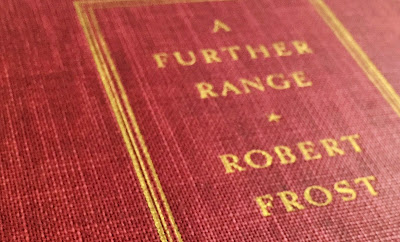BY Robert Frost
Book Information: 1/1/0/US/HH/1936/o.4,000 • 225x148x16 • 336 • Pulitzer'37
"A Further Range" was published in 1936 by Henry Holt and won the Pulitzer Prize in 1937, Frost's third of four. This first trade edition has a first printing run of 4,000 copies. The true first edition is a signed limited edition of 803 copies.
This is the first trade edition first printing with first state dust jacket that is unclipped with no price indication, consistent with Crane's description. The book is bound in red clothed board with gilt lettering and has red topstain. The copyright page should state "FIRST PRINTING". If the copyright page lacks the "First PRINTING" statement but indicates "Copyright, 1936", then it is either a second printing of the first trade edition, which is still valuable, or a book club edition, which is probably worthless. To differentiate a first trade edition second printing from a book club edition:
- check the page numbers 16, 21, 29, 36, 40, 44, 48, 53, 56, 61, and 64. For the first trade edition, the font type for these page numbers are consistent with the rest of the page numbers. For the book club edition, these page numbers are in a different font type. The story is some printing plates were damaged during transportation prior to the printing of the book club edition and replacements were made, thus the inconsistency.
- Measure the front board cover. The first trade edition is smaller at 222mm by 144mm while the book club edition measures 225mm by 149mm. The difference is quite small, but if your book measures less than 225mm by 149mm, it is likely the more desirable trade edition.
- Check the blank pages. For the first trade edition, there is a blank leaf between the ffep and the half-title page. The book club edition does not have this blank leaf. Also, the first trade edition ends on the final leaf and its recto is therefore the rear free endpaper. For the book club edition, there is a blank leaf separating the final printed page and the rear free endpaper.
This book is getting increasingly rare and a VG copy of the first printing can be purchased from eBay or Abebooks for $200 onwards. A VG copy of the second printing , with a print run of 6,000 copies and are sometimes mistaken for first impression, sells at around $50. The book club edition has a print run of 59,000, and is not worth much. This is a VG first printing copy with a VG dust jacket with minor chippings, rubbings and closed tears, and a VG+ book that is tight and clean but with significant gilt loss on the spine.
The only official signed edition is the 803-copy limited signed edition. There are many association or signed copies of this trade edition, and some are priced as high as a few thousand dollars, some with very bad dust jacket. Robert Frost's signature and handwriting are both prone to forgery, so caveat emptor. If you really want a signed copy, go for the official signed edition for about $750.
 |
| The dust jackets for the first trade edition (first or second impression) and the book club edition are identical. Some book sellers will marry a first edition book with a better-condition dust jacket from a book club edition, a practice that should be disclosed. In this case, it is virtually impossible to tell. This jacket has some chipping at the top of the spine but is still very good. |
 |
| The internal flaps. The book sold for $2.50 in 1936, or just about $12 in today's equivalent assuming 2% average inflation. A copy with very good dust jacket now sells for about $200-$400 on abebooks. |
 |
| The board in red rough linen cloth and gilt lettering. |
 |
| The spine is also gilt. On the right is the first impression copy, regrettably with the gilt almost entirely faded. The copy on the left is a second impression with very nice gilt. |
 |
| The full title page. |
 |
| The copyright page is important for identification. Here is the copyright page of the first trade edition first impression, as evidenced by the "First Printing" imprinted. If this is missing, then the book is either a first trade edition second impression or a book club edition distinguishable by the points discussed above. |
 |
| The first poem on page 13. |
 |
| The last page on 102. |
 |
| This is the copyright page of a first edition second impression copy. Note that "First Printing" is absent from the copyright page. Again, the book club edition's copyright page is identical so other points need to be checked to differentiable the two. |
 |
| The first trade editions have dull red stained top edge. |

















Comments
Post a Comment